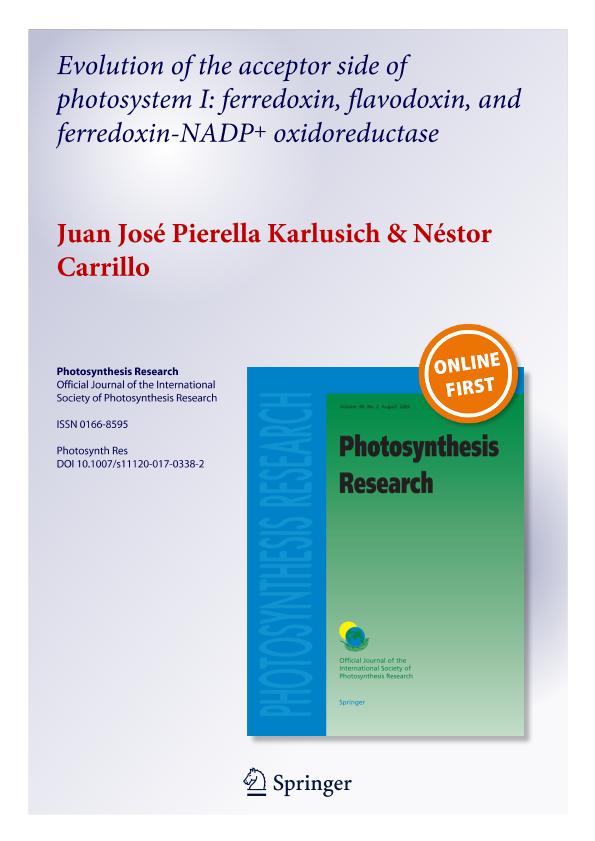Mostrar el registro sencillo del ítem
dc.contributor.author
Pierella Karlusich, Juan José

dc.contributor.author
Carrillo, Nestor Jose

dc.date.available
2018-06-27T19:18:35Z
dc.date.issued
2017-12
dc.identifier.citation
Pierella Karlusich, Juan José; Carrillo, Nestor Jose; Evolution of the acceptor side of photosystem I: ferredoxin, flavodoxin, and ferredoxin-NADP+ oxidoreductase; Springer; Photosynthesis Research; 134; 3; 12-2017; 235-250
dc.identifier.issn
0166-8595
dc.identifier.uri
http://hdl.handle.net/11336/50295
dc.description.abstract
The development of oxygenic photosynthesis by primordial cyanobacteria ~2.7 billion years ago led to major changes in the components and organization of photosynthetic electron transport to cope with the challenges of an oxygen-enriched atmosphere. We review herein, following the seminal contributions as reported by Jaganathan et al. (Functional genomics and evolution of photosynthetic systems, vol 33, advances in photosynthesis and respiration, Springer, Dordrecht, 2012), how these changes affected carriers and enzymes at the acceptor side of photosystem I (PSI): the electron shuttle ferredoxin (Fd), its isofunctional counterpart flavodoxin (Fld), their redox partner ferredoxin-NADP+ reductase (FNR), and the primary PSI acceptors Fx and FA/FB. Protection of the [4Fe–4S] centers of these proteins from oxidative damage was achieved by strengthening binding between the FA/FB polypeptide and the reaction center core containing Fx, therefore impairing O2 access to the clusters. Immobilization of FA/FB in the PSI complex led in turn to the recruitment of new soluble electron shuttles. This function was fulfilled by oxygen-insensitive [2Fe–2S] Fd, in which the reactive sulfide atoms of the cluster are shielded from solvent by the polypeptide backbone, and in some algae and cyanobacteria by Fld, which employs a flavin as prosthetic group and is tolerant to oxidants and iron limitation. Tight membrane binding of FNR allowed solid-state electron transfer from PSI bridged by Fd/Fld. Fine tuning of FNR catalytic mechanism led to formidable increases in turnover rates compared with FNRs acting in heterotrophic pathways, favoring Fd/Fld reduction instead of oxygen reduction.
dc.format
application/pdf
dc.language.iso
eng
dc.publisher
Springer

dc.rights
info:eu-repo/semantics/openAccess
dc.rights.uri
https://creativecommons.org/licenses/by-nc-sa/2.5/ar/
dc.subject
Evolution
dc.subject
Ferredoxin
dc.subject
Ferredoxin-Nadp+ Reductase
dc.subject
Flavodoxin
dc.subject
Oxygenic Photosynthesis
dc.subject
Photosystem I
dc.subject.classification
Otras Ciencias Biológicas

dc.subject.classification
Ciencias Biológicas

dc.subject.classification
CIENCIAS NATURALES Y EXACTAS

dc.title
Evolution of the acceptor side of photosystem I: ferredoxin, flavodoxin, and ferredoxin-NADP+ oxidoreductase
dc.type
info:eu-repo/semantics/article
dc.type
info:ar-repo/semantics/artículo
dc.type
info:eu-repo/semantics/publishedVersion
dc.date.updated
2018-06-26T22:33:43Z
dc.journal.volume
134
dc.journal.number
3
dc.journal.pagination
235-250
dc.journal.pais
Países Bajos

dc.journal.ciudad
Dordrecht
dc.description.fil
Fil: Pierella Karlusich, Juan José. Consejo Nacional de Investigaciones Científicas y Técnicas. Centro Científico Tecnológico Conicet - Rosario. Instituto de Biología Molecular y Celular de Rosario. Universidad Nacional de Rosario. Facultad de Ciencias Bioquímicas y Farmacéuticas. Instituto de Biología Molecular y Celular de Rosario; Argentina
dc.description.fil
Fil: Carrillo, Nestor Jose. Consejo Nacional de Investigaciones Científicas y Técnicas. Centro Científico Tecnológico Conicet - Rosario. Instituto de Biología Molecular y Celular de Rosario. Universidad Nacional de Rosario. Facultad de Ciencias Bioquímicas y Farmacéuticas. Instituto de Biología Molecular y Celular de Rosario; Argentina
dc.journal.title
Photosynthesis Research

dc.relation.alternativeid
info:eu-repo/semantics/altIdentifier/doi/https://dx.doi.org/10.1007/s11120-017-0338-2
dc.relation.alternativeid
info:eu-repo/semantics/altIdentifier/url/https://link.springer.com/article/10.1007%2Fs11120-017-0338-2
Archivos asociados
